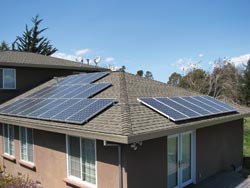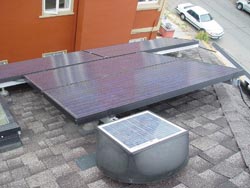Solar panels produce DC power that must be converted to AC to feed into the electrical needs of a home or building, or back into the grid. In this traditional solar design, all panels are connected in series – just like Christmas lights – to a large DC converter.
Although this has worked over the years, it has its drawbacks. First, as the Christmas light analogy implies, if one panel is affected by shade, debris or failure, it affects the entire string. Other common challenges include panel mismatch – where the lowest-producing panel dictates the output of all panels – and tricky installations on multiple rooftops (ever notice how solar installations are usually only on one roof face?). The Christmas light effect has never been widely discussed because, until now, there has not been a solution.
Enter the microinverter
Changing the traditional electrical design of today’s solar system is a new technology called the microinverter. Its concept is that each panel gets its own microinverter rather than having all panels connect to one large inverter.
Brian Quock, director of sales and marketing for Owens Electric & Solar of San Mateo, Calif., a designer and installer of solar systems, has seen firsthand the benefits of the microinverter concept. He noted that the first company out of the gate with a microinverter offering was Enphase Energy of Petaluma, Calif., but said others will join in, including SmartSpark of Champaign, Ill., which is working on a solution based on technology developed at the University of Illinois.

Individual microinverters enable multiple rooftop installations. Photo courtesy of Enphase Energy.
Brian Precious, director of marketing at SmartSpark, said the company anticipates a product launch in the first quarter of 2010. Called the SolarBridge, the product will function similarly to Enphase’s but will be integrated into the panels.
One per panel
The technology behind the Enphase system is that one microinverter is installed under each panel, enabling it to output AC power. This means that each panel is now an independent power producer, making it “much easier to engineer and size a system,” Quock said. All issues associated with panel mismatch and obstructions caused by dust, debris and shade are eliminated. Adding on to the system at a later date is possible. And, finally, risk of inverter failure is distributed throughout the whole system. Quock explained that, rather than having the whole system go down when one or two microinverters fail, “you only lose production for those one or two.”

The microinverter approach is shown here on a sunny rooftop. Photo courtesy of Owens Electric & Solar.
Besides converting DC to AC power, microinverter technology offers the ability to monitor and analyze power. Each microinverter can be connected to the Internet via a communications gateway connected to the homeowner’s broadband router. Homeowners can go online to view how their system is performing in real time, or they can view historic data. SmartSpark also will have a monitoring system, although probably not with online capability right off the bat.
Cost is a consideration because microinverter hardware is more expensive than a single inverter box. However, Quock noted that there is some savings in engineering time and labor, but, more importantly, that the cost per kilowatt hour produced is lower.
“It’s not really the number of solar panels you are buying but what a system generates,” he explained. “It’s like buying a car with a large V-8 engine that gets only 300 horsepower and 18 miles per gallon, but what if you can get a car with a V-6 engine that gets 330 horsepower and 28 miles per gallon for just a little more cost?